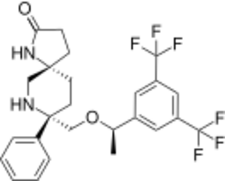Chemistry:Rolapitant
 | |
| Clinical data | |
|---|---|
| Pronunciation | /roʊˈlæpɪtænt/ roh-LAP-i-tant |
| Trade names | Varubi (US), Varuby (EU) |
| Other names | SCH 619734 |
| AHFS/Drugs.com | Monograph |
| MedlinePlus | a615041 |
| License data |
|
| Pregnancy category |
|
| Routes of administration | By mouth (tablets), intravenous |
| Drug class | NK1 receptor antagonists, antiemetics |
| ATC code | |
| Legal status | |
| Legal status | |
| Pharmacokinetic data | |
| Bioavailability | nearly 100% |
| Protein binding | 99.8% |
| Metabolism | CYP3A4 |
| Metabolites | C4-pyrrolidine-hydroxylated rolapitant (major) |
| Elimination half-life | 169–183 hours |
| Excretion | Feces (52–89%), urine (9–20%)[1] |
| Identifiers | |
| |
| CAS Number | |
| PubChem CID | |
| IUPHAR/BPS | |
| DrugBank | |
| ChemSpider | |
| UNII | |
| KEGG | |
| ChEBI | |
| Chemical and physical data | |
| Formula | C25H26F6N2O2 |
| Molar mass | 500.485 g·mol−1 |
| 3D model (JSmol) | |
| |
| |
Rolapitant (INN,[2] trade name Varubi /vəˈruːbi/ və-ROO-bee in the US and Varuby in the European Union) is a drug originally developed by Schering-Plough and licensed for clinical development by Tesaro, which acts as a selective NK1 receptor antagonist (antagonist for the NK1 receptor).[3] It has been approved as a medication for the treatment of chemotherapy-induced nausea and vomiting (CINV) after clinical trials showed it to have similar or improved efficacy and some improvement in safety over existing drugs for this application.[4][5][6][7]
Medical uses
Rolapitant is used in combination with other antiemetic (anti-vomiting) agents in adults for the prevention of delayed nausea and vomiting associated with initial and repeat courses of emetogenic cancer chemotherapy, including, but not limited to, highly emetogenic chemotherapy.[1] The approved antiemetic combination consists of rolapitant plus dexamethasone and a 5-HT3 antagonist.[8]
Contraindications
Under the US approval, rolapitant is contraindicated in combination with thioridazine, whose inactivation could be inhibited by rolapitant.[1] Under the European approval, it is contraindicated in combination with St. John's Wort, which is expected to accelerate inactivation of rolapitant.[8]
Side effects
In studies comparing chemotherapy plus rolapitant, dexamethasone and a 5-HT3 antagonist to chemotherapy plus placebo, dexamethasone and a 5-HT3 antagonist, most side effects had comparable frequencies in both groups, and differed more between chemotherapy regimens than between rolapitant and placebo groups. Common side effects included decreased appetite (9% under rolapitant vs. 7% under placebo), neutropenia (9% vs. 8% or 7% vs. 6%, depending on the kind of chemotherapy), dizziness (6% vs. 4%), indigestion and stomatitis (both 4% vs. 2%).[1]
Overdose
Up to eightfold therapeutic doses have been given in studies without problems.[8]
Interactions
Rolapitant moderately inhibits the liver enzyme CYP2D6. Blood plasma concentrations of the CYP2D6 substrate dextromethorphan have increased threefold when combined with rolapitant; and increased concentrations of other substrates are expected. The drug also inhibits the transporter proteins ABCG2 (breast cancer resistance protein, BCRP) and P-glycoprotein (P-gp), which has been shown to increase plasma concentrations of the ABCG2 substrate sulfasalazine twofold and the P-gp substrate digoxin by 70%.[8]
Strong inducers of the liver enzyme CYP3A4 decrease the area under the curve of rolapitant and its active metabolite (called M19); for rifampicin, this effect was almost 90% in a study. Inhibitors of CYP3A4 have no relevant effect on rolapitant concentrations.[8]
Pharmacology
Pharmacodynamics
Both rolapitant and its active metabolite M19 block the NK1 receptor with high affinity and selectivity: to block the closely related receptor NK2 or any other of 115 tested receptors and enzymes, more than 1000-fold therapeutic concentrations are necessary.[9]
Pharmacokinetics

Rolapitant is practically completely absorbed from the gut, independently of food intake. It undergoes no measurable first-pass effect in the liver. Highest blood plasma concentrations are reached after about four hours. When in the bloodstream, 99.8% of the substance are bound to plasma proteins.[8]
It is metabolized by the liver enzyme CYP3A4, resulting in the major active metabolite M19 (C4-pyrrolidine-hydroxylated rolapitant) and a number of inactive metabolites. Rolapitant is mainly excreted via the feces (52–89%) in unchanged form, and to a lesser extent via the urine (9–20%) in form of its inactive metabolites. Elimination half-life is about seven days (169 to 183 hours) over a wide dosing range.[8]
Chemistry
The drug is used in form of rolapitant hydrochloride monohydrate, a white to off-white, slightly hygroscopic crystalline powder. Its maximum solubility in aqueous solutions is at pH 2–4.[9]
See also
References
- ↑ 1.0 1.1 1.2 1.3 1.4 "Varubi- rolapitant tablet". 6 August 2019. https://dailymed.nlm.nih.gov/dailymed/drugInfo.cfm?setid=a52896cd-4a98-49b8-82db-bf1985a64d97.
- ↑ "International Nonproprietary Names for Pharmaceutical Substances (INN). Recommended International Nonproprietary Names (Rec. INN): List 59". World Health Organization. p. 64. https://www.who.int/medicines/publications/druginformation/innlists/RL59.pdf.
- ↑ "Rolapitant (SCH 619734): a potent, selective and orally active neurokinin NK1 receptor antagonist with centrally-mediated antiemetic effects in ferrets". Pharmacology, Biochemistry, and Behavior 102 (1): 95–100. July 2012. doi:10.1016/j.pbb.2012.03.021. PMID 22497992.
- ↑ "Recent developments in the prevention of chemotherapy-induced nausea and vomiting (CINV): a comprehensive review". Annals of Oncology 26 (6): 1081–90. June 2015. doi:10.1093/annonc/mdv138. PMID 25755107.
- ↑ "Recent Advances in Preventing Chemotherapy-Induced Nausea and Vomiting". Oncology 30 (8): 750–62. August 2016. PMID 27539626.
- ↑ "Efficacy and safety of rolapitant for prevention of chemotherapy-induced nausea and vomiting over multiple cycles of moderately or highly emetogenic chemotherapy". European Journal of Cancer 57: 23–30. April 2016. doi:10.1016/j.ejca.2015.12.023. PMID 26851398.
- ↑ "Rolapitant for the treatment of chemotherapy-induced nausea and vomiting: a review of the clinical evidence". Future Oncology 12 (6): 763–78. March 2016. doi:10.2217/fon.16.11. PMID 26842387.
- ↑ 8.0 8.1 8.2 8.3 8.4 8.5 8.6 8.7 "Varuby: EPAR – Product Information". European Medicines Agency. 2017-05-31. http://www.ema.europa.eu/docs/en_GB/document_library/EPAR_-_Product_Information/human/004196/WC500228742.pdf.
- ↑ 9.0 9.1 "Varuby: EPAR – Public assessment report". European Medicines Agency. 2017-05-31. http://www.ema.europa.eu/docs/en_GB/document_library/EPAR_-_Public_assessment_report/human/004196/WC500228744.pdf.
External links
- "Rolapitant". Drug Information Portal. U.S. National Library of Medicine. https://druginfo.nlm.nih.gov/drugportal/name/rolapitant.
- "Rolapitant Injection: MedlinePlus Drug Information". 20 August 2020. https://medlineplus.gov/druginfo/meds/a618019.html.
 |

